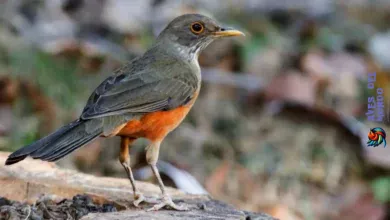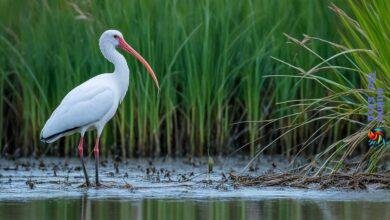Did you know that the Frigatebird has the largest wingspan-to-body size ratio of any bird species? With a wingspan stretching up to 7.5 feet, these incredible creatures are truly remarkable. Not only are they skilled airborne predators, but they also have a unique diet and impressive navigational abilities. Join us as we delve into the fascinating world of the Frigatebird, a tropical seabird that defies gravity and captures the imagination.
The Frigatebird is a Master of the Skies
The Frigatebird, also known as the “Pirate of the Air,” is a remarkable bird that reigns supreme in the skies. With its impressive wingspan and soaring abilities, it is a true marvel of nature.

The Frigatebird’s aerial abilities are unmatched, allowing it to effortlessly glide through the air for extended periods. Its wingspan, measuring up to 7.5 feet, enables it to cover vast distances swiftly and efficiently.
This seabird’s flight abilities are nothing short of extraordinary. It can stay airborne for days at a time, showcasing its exceptional endurance and mastery of flight. Whether soaring high above the ocean or gracefully maneuvering with precision, the Frigatebird is a sight to behold.
«Just to watch them is an inspiration, because they are truly masters of their environment.» – David Attenborough
The Impressive Wingspan of the Frigatebird
The Frigatebird possesses an impressive wingspan, spanning up to 7.5 feet. This wingspan allows the bird to effortlessly navigate the skies and take advantage of air currents, minimizing the effort required for sustained flight.
Flight Abilities of the Frigatebird
The Frigatebird’s flight abilities are truly awe-inspiring. It can soar for long periods, rarely needing to land. This exceptional capacity is achieved through a combination of physical adaptations and flying techniques.
| Flight Abilities | Description |
|---|---|
| Aerial Acrobatics | The Frigatebird is known for its intricate aerial maneuvers and graceful flight displays, showcasing supreme agility. |
| Effortless Soaring | With its expansive wingspan and lightweight body, the Frigatebird can glide effortlessly for extended periods, conserving energy. |
| Endurance | These magnificent birds can stay airborne for days, relying on their efficient flying techniques and endurance adaptations. |
It Has the Largest Wingspan in Comparison to Its Body Size
When it comes to wingspan, the Frigatebird reigns supreme. This magnificent creature boasts the largest wingspan-to-body size ratio of any bird species. With a wingspan that can measure up to an impressive 7.5 feet, the Frigatebird is truly a marvel of nature.

This exceptional wingspan enables the Frigatebird to glide effortlessly through the air for extended periods, showcasing its remarkable aerial abilities. With wings that span such great lengths, this airborne wonder can cover vast distances with ease.
Comparison of Wingspans: Frigatebird vs. Other Birds
| Bird Species | Wingspan | Wing Size Ratio |
|---|---|---|
| Frigatebird | Up to 7.5 feet | Highest |
| Albatross | Up to 11 feet | High |
| Wandering albatross | Up to 12 feet | High |
| California condor | Up to 9.5 feet | High |
| Andean condor | Up to 10.5 feet | High |
| Snowy albatross | Up to 11.8 feet | High |
They Have a Unique Adaptation for Flight
The Frigatebird possesses an extraordinary adaptation for flight, which sets it apart from other bird species. This adaptation lies in its long, slender wings, allowing it to effortlessly glide through the air for extended periods.
The frigate bird’s wingspan is truly remarkable, measuring up to 7.5 feet. These expansive wings, combined with its lightweight body, enable the frigatebird to cover vast distances swiftly and efficiently.
This flight adaptation is crucial for the frigatebird’s survival and lifestyle. With its remarkable aerial abilities, they can search for food, locate mates, and navigate across the open ocean with remarkable ease.
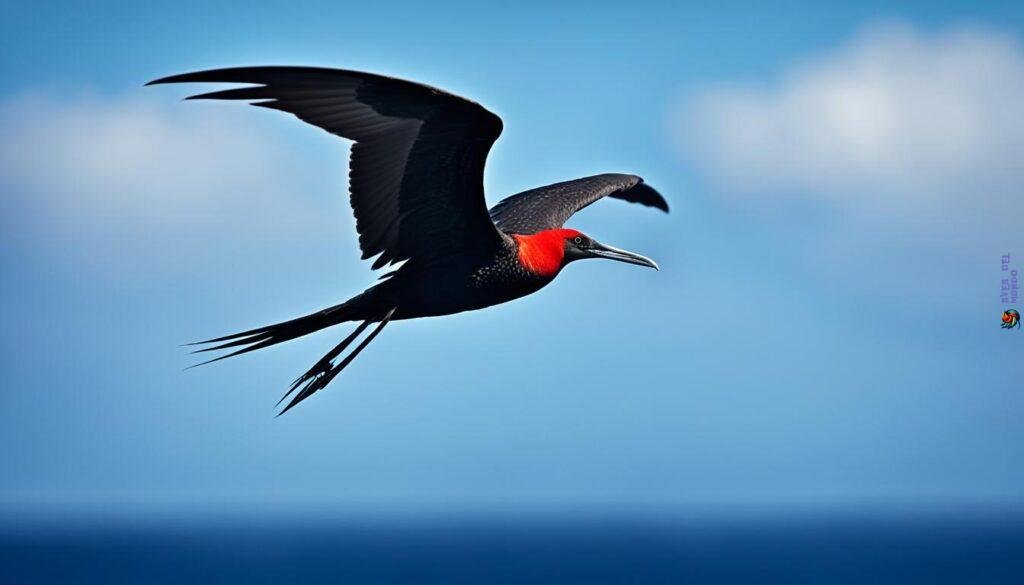
These long, slender wings provide the frigatebird with exceptional maneuverability, allowing it to perform intricate aerial acrobatics with grace and precision. It can effortlessly soar high in the sky, showcasing its mastery over the skies.
The flight adaptation of the frigatebird not only serves as a means of transportation but also as an integral part of its hunting technique. With its impressive aerial skills, it can spot prey from high above and swoop down swiftly to catch fish while in flight.
The unique adaptation of long, slender wings sets the frigatebird apart in the avian world and contributes to its status as a marvelous aerial creature.
They Are Master Fishermen
The Frigatebird showcases remarkable fishing skills, making it a true master of the skies. With its extraordinary hunting techniques, this avian marvel can catch fish while in mid-flight. It employs a specialized hunting technique that involves hovering over the water’s surface, ready to pounce on its unsuspecting prey with pinpoint precision.
Fishing Technique
The Frigatebird’s hunting technique is a sight to behold. It scans the water from high above, using its keen eyesight to locate schools of fish swimming near the surface. Once it spots its target, it changes its flight pattern and glides effortlessly towards the prey.
With impeccable timing and agility, the Frigatebird dives towards the water, extending its sharp beak at the last moment. It swiftly snatches up its prey, grasping it firmly in its beak before ascending back into the sky.

This image showcases the Frigatebird in action, demonstrating its fishing skills and aerial prowess.
The Blue Wonder: Frigatebird’s Special Fishing Skills
What makes the Frigatebird’s fishing skills truly remarkable is its ability to catch fish without actually touching the water. Unlike other seabirds that rely on diving into the water to catch their prey, the Frigatebird prefers a more opportunistic approach.
By remaining airborne and keeping a watchful eye, the Frigatebird opportunistically scavenges for fish that are chased to the surface by other marine predators, such as dolphins or tuna. It is quick to swoop in and snatch the fish before it has a chance to escape.
«The Frigatebird’s fishing skills are awe-inspiring. Their ability to catch fish in mid-air without making contact with the water is truly remarkable.»
– Dr. Marine Biology
| Fish Species | Prey Size | Frequency |
|---|---|---|
| Anchovies | Small | High |
| Sardines | Medium | Moderate |
| Tuna | Large | Occasional |
The table illustrates the Frigatebird’s diverse prey preferences based on fish species, prey size, and the frequency of their hunting successes.
With its extraordinary fishing skills and unparalleled hunting technique, the Frigatebird has truly mastered the art of survival high above the ocean’s expanse.
They Have an Unusual Diet
While the Frigatebird primarily feeds on fish, it also scavenges and steals food from other birds. These aerial scavengers are not afraid to engage in high-stakes food theft by harassing their fellow avian species to relinquish their catch. With their impressive aerial skills, Frigatebirds take advantage of their maneuverability to intimidate and pester other birds until they drop their prey. Once the food is discarded, the Frigatebird swiftly seizes the opportunity to claim the stolen meal for itself.

These cunning scavengers showcase their resourcefulness by capitalizing on the efforts of other birds and benefiting from their hard-earned meals. By stealing food, Frigatebirds can supplement their diet and ensure their survival, even in the absence of successful fishing expeditions.
| Food Sources | Description |
|---|---|
| Fish | The primary food source for Frigatebirds, including small fish such as flying fish, mackerel, and sardines. |
| Scavenged Prey | Frigatebirds opportunistically scavenge food from other bird species, stealing their catch by intimidating or harassing them until they let go. |
This unique feeding behavior sets the Frigatebird apart from many other bird species and highlights its adaptability in acquiring sustenance. By utilizing their aerial agility and tactics, Frigatebirds can thrive in various habitats, ensuring a diverse diet and increasing their chances of survival.
Frigatebirds Can Stay in Flight for Days
One of the most remarkable abilities of frigatebirds is their exceptional flight duration. These incredible birds have the unique capability to remain airborne for days at a time, utilizing their efficient flying techniques and specialized adaptations.
Unlike most birds that rely on periodic rests or perches, frigatebirds rarely land on solid ground unless necessary, such as for nesting or breeding purposes. They have perfected the art of staying airborne, allowing them to traverse vast distances without the need for frequent breaks.
With their extensive wingspan and streamlined body, frigatebirds possess the physical attributes necessary for sustained flight. Their long, slender wings enable effortless gliding and soaring through the skies, conserving energy for extended periods.
Acquiring sustenance while in flight is another remarkable aspect of their airborne lifestyle. Instead of diving into the water like many seabirds, frigatebirds rely on their keen eyesight and incredible agility to intercept prey mid-air. They snatch fish and even steal food from other birds, showcasing their remarkable hunting prowess.
«Frigatebirds have evolved to be true aerial marvels, capable of staying airborne for days and utilizing their unique adaptations to navigate the vast oceanic skies. Their ability to perform prolonged flights without resting is truly awe-inspiring.»
This exceptional flight duration is made possible through a combination of physiological and behavioral adaptations. Frigatebirds have highly efficient respiratory and cardiovascular systems that enable them to meet the oxygen demands of sustained flight. Additionally, their diet, which includes predominantly fish, provides the necessary energy for endurance flying.
This incredible feat of staying airborne for days allows frigatebirds to explore vast territories, locate food sources, and navigate their oceanic habitats with unparalleled efficiency. It is a testament to their mastery of the skies and their remarkable adaptation to their unique ecological niche.

Frigatebird Flight Duration compared to other Bird Species
| Bird Species | Average Flight Duration |
|---|---|
| Frigatebird | Days |
| Albatross | Weeks |
| Swift | Months |
| Hummingbird | Hours |
They Have a Prominent Red Throat Pouch
Male Frigatebirds are known for their eye-catching appearance, highlighted by a vibrant red throat pouch. This unique physical feature becomes prominently inflated during the mating season, creating a striking display that captivates the attention of females.
The red throat pouch serves as a visual signal of male frigatebirds’ reproductive fitness and plays a crucial role in courtship displays. The male inflates his pouch, creating a balloon-like structure that contrasts beautifully against the bird’s black feathers.
This fascinating courtship behavior showcases the male frigatebird’s ability to attract potential mates by displaying his physical prowess and offering a captivating spectacle against the backdrop of the sky. It is a truly remarkable example of avian courtship and evolutionary adaptation.
| Frigatebird Species | Red Throat Pouch Display |
|---|---|
| Magnificent Frigatebird | Males inflate their throat pouches, rhythmically drumming them in courtship displays. |
| Great Frigatebird | Throat pouches are inflated to impressive sizes, with males tilting their heads backward to further accentuate the red color. |
| Australian Lesser Frigatebird | Males display their inflated pouches while beak clapping and wagging their heads in a synchronized manner. |
| Christmas Island Frigatebird | The red throat pouches of males become inflated and hang down like a pendulum during courtship rituals. |
These courtship displays not only demonstrate the male’s physical fitness but also serve as a means of communication with potential mates. The vibrant red throat pouch acts as a visual cue to signal reproductive readiness and attract female frigatebirds.

Whether it’s through inflating their red throat pouches, performing elaborate aerial displays, or showcasing their unique adaptations, frigatebirds continue to dazzle and captivate with their exceptional charm and beauty.
Females Lay a Single Egg at a Time
Female Frigatebirds have a unique reproductive behavior. They typically lay only one egg at a time, ensuring their undivided attention and care for each offspring. This single egg is a result of their meticulous breeding process, where mating pairs carefully select a suitable location for their nest, often in densely populated colonies.
Once the female Frigatebird lays her single egg, both parents take turns incubating it. This shared responsibility allows for optimal care and protection of the developing embryo. The incubation period lasts for approximately two months, during which the parents maintain a constant vigilance to ensure the egg remains undisturbed and at the right temperature for successful development.
The Frigatebird eggs are large and white, perfectly camouflaged against the nest’s surroundings. The size of the egg ensures sufficient nutrients and resources for the growing chick inside. It is fascinating to witness the dedication and commitment displayed by the Frigatebird parents as they prioritize the survival and well-being of their single offspring.
«The Frigatebird’s reproductive behavior is a testament to their protective nature and commitment to their offspring. The single egg represents the parents’ meticulous care and the subsequent chick’s future. It is a remarkable process in the world of avian reproduction.»
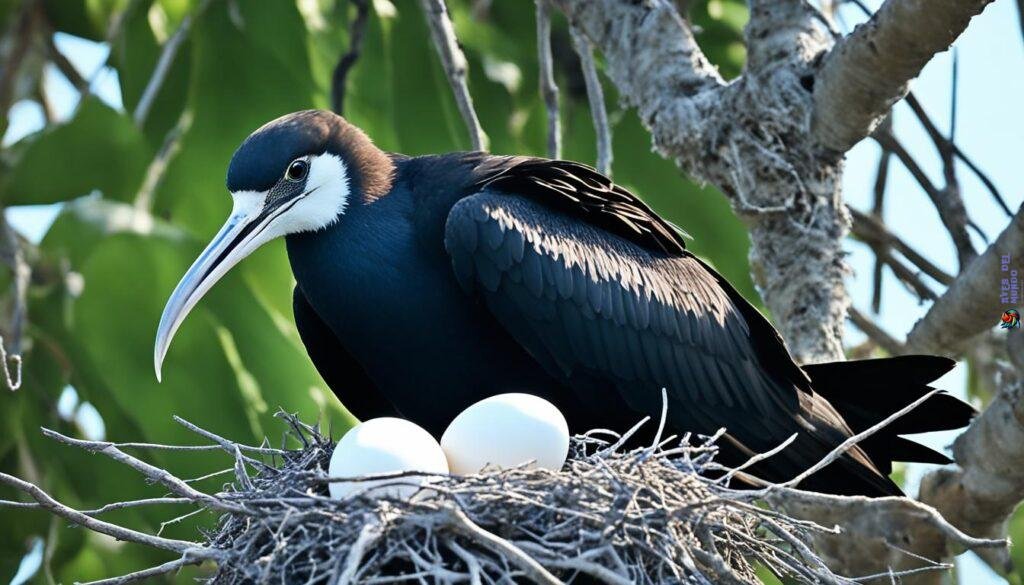
The image above showcases the Frigatebird’s reproductive behavior, highlighting the single egg within the nest. It captures the intricacies of their nesting strategy and the devotion of the parents to their growing chick.
They Are Excellent Navigators
Frigatebirds possess remarkable navigation skills that enable them to embark on long-distance travels across the vast ocean without losing their way. These skilled aviators utilize a combination of external cues and innate abilities to navigate through their journey.
Upon taking flight, frigatebirds rely on various landmarks to orient themselves and maintain their course. Whether it’s distant islands, coral reefs, or other identifiable features, these natural landmarks serve as beacons guiding them through their long-distance adventures.
Furthermore, frigatebirds harness the power of celestial cues to navigate accurately. They are known to use the position of the sun, moon, and stars as points of reference to establish their direction and maintain a steady course. By carefully observing and interpreting the changing positions of celestial bodies, frigatebirds can effectively navigate their way across vast expanses of open sea.
But their navigational prowess doesn’t stop there. These remarkable birds also possess a special sensitivity to the Earth’s magnetic fields, which helps them maintain their heading during their impressive long-distance journeys. By tapping into the Earth’s magnetic field, frigatebirds can accurately determine their position and adjust their flight path if needed.
«Frigatebirds are true navigational marvels, utilizing a combination of natural landmarks, celestial cues, and magnetic fields to traverse the vast expanse of the ocean with precision and grace.»
With their remarkable navigation skills, frigatebirds effortlessly navigate through the vastness of the open ocean, reaching their destinations with remarkable accuracy.
| Navigation Skills of Frigatebirds | Description |
|---|---|
| Landmark Navigation | Utilize natural landmarks, such as islands and reefs, as guiding points throughout their journey. |
| Celestial Navigation | Use the positions of the sun, moon, and stars to establish direction and maintain course. |
| Magnetic Field Sensitivity | Tap into the Earth’s magnetic field to accurately determine position and adjust flight path. |
In conclusion, frigatebirds possess exceptional navigation skills that enable them to undertake long-distance travels across the ocean with astonishing precision. By utilizing various cues from natural landmarks, celestial bodies, and magnetic fields, they navigate their way through the open skies, showcasing their mastery of the heavens.
Frigatebird Chicks Can Take Up to Six Months to Fledge
Once the Frigatebird chicks hatch, they embark on a remarkable journey of growth and development. During this period, they rely completely on their parents for nourishment, protection, and essential life skills. It is a time of immense vulnerability and dependence as they prepare for the challenges of the wild.
Chick development in Frigatebirds is a gradual process that spans several months. From the moment they break free from their shells, these tiny creatures are entirely reliant on their parents’ care. They are fed a nutrient-rich diet consisting of regurgitated fish and other prey items. This sustains their growth and provides them with the crucial nutrients needed to build strength and develop their flight feathers.
Over time, the chicks grow rapidly, gradually shedding their fluffy down feathers and replacing them with sleek, waterproof plumage. As their bodies mature, they begin to exercise their wings, flapping them vigorously in preparation for the day they take flight. This process helps strengthen their flight muscles and develop the necessary coordination required for sustained flight.
The fledging period, the time when the chicks leave the nest and take their first flight, can take up to six months. This is a critical milestone in their lives and marks their transition into independent individuals. Throughout this period, the parents continue to support their offspring, providing guidance and protection as they gradually gain confidence in their flying abilities.
During the fledging period, Frigatebird chicks face various challenges. They must learn to navigate the aerial environment, recognize and catch their own prey, and compete with other birds for limited resources. It is a time of learning and adaptation as they acquire the necessary skills to survive in their highly competitive and ever-changing world.
The fledging period is a remarkable testament to the resilience and adaptability of these young Frigatebirds. As they embark on their first flights, they join the ranks of the skilled aviators that rule the skies. Their journey from fragile hatchlings to powerful, independent birds is a testament to the wonders of nature’s design.

They Are Highly Skilled Aerial Acrobats
The Frigatebird is truly a marvel in the skies, known for its extraordinary aerial acrobatics and breathtaking flight maneuvers. With its sleek and streamlined body, this magnificent bird gracefully soars through the air, captivating all who witness its mastery of flight.
Equipped with powerful wings and an impressive wingspan, the Frigatebird can perform intricate aerial maneuvers with ease. Its swift and agile movements make it a true spectacle to behold, as it effortlessly twists, turns, and dives through the open sky.
These skilled aviators showcase their abilities through a series of mesmerizing flight displays, showcasing their agility and grace. Whether performing high-speed dives or executing intricate aerial loops, the Frigatebird’s aerial acrobatics leave onlookers in awe of its incredible talent.
«The Frigatebird’s flight maneuvers are a testament to their adaptability and agility in the air. Their mastery of aerial acrobatics is unrivaled among seabirds.»
With their exceptional aerial skills, Frigatebirds are capable of staying in flight for extended periods. They possess the remarkable ability to glide effortlessly on thermals and air currents, conserving energy as they navigate the vast expanses of the ocean.
The Frigatebird’s aerial prowess is not limited to mere flight; it extends to their remarkable hunting techniques as well. These birds are highly adept at snatching fish from the water’s surface, displaying their precision and agility even during the pursuit of their prey.
Witnessing a Frigatebird in action is an awe-inspiring experience, as it effortlessly demonstrates its mastery of the skies. Whether performing daring aerial maneuvers or engaging in remarkable flight displays, the Frigatebird is a true wonder of nature.
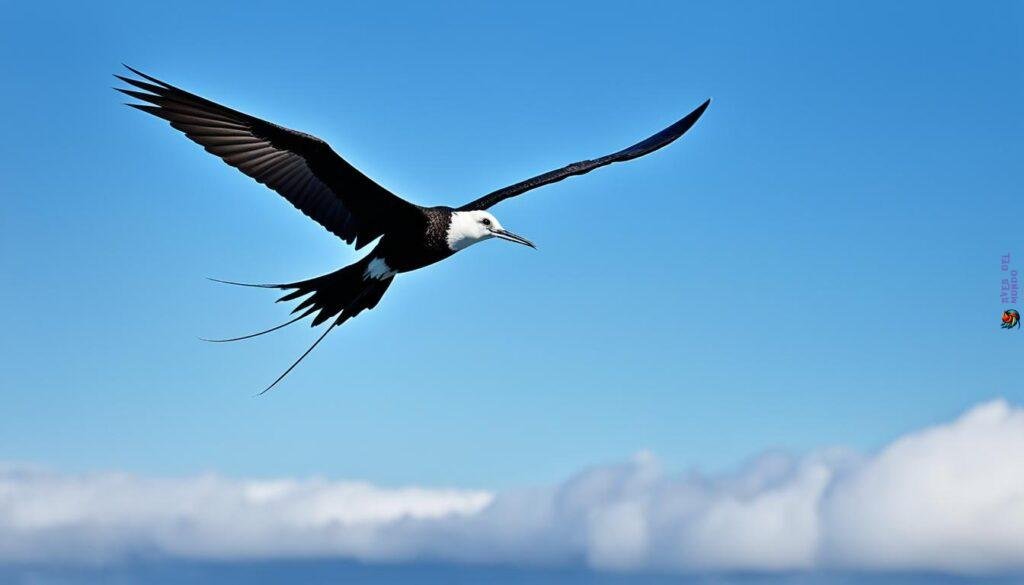
| Unique Features | Flight Maneuvers |
|---|---|
| Impressive wingspan | High-speed dives |
| Sleek and streamlined body | Intricate aerial loops |
| Exceptional agility | Swift twists and turns |
| Able to stay in flight for extended periods | Precision in hunting |
They Are Found in Tropical and Subtropical Regions
Frigatebirds are remarkable avian creatures that can be found in various tropical and subtropical regions across the globe. These magnificent birds thrive in warm coastal habitats and have adapted well to their unique environments.
From the enchanting Caribbean islands to the breathtaking Pacific Islands, frigatebirds grace the skies with their presence. Their distinctive silhouette can also be spotted in parts of Africa and South America, where they add to the vibrant biodiversity of these regions.
Their ability to thrive in these habitats is a testament to their exceptional adaptability and resilience. Frigatebirds have honed their skills to navigate the warm, tropical winds and make the most of the abundant resources available in these regions.
